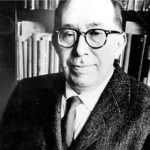A novel can be a kind of courtroom. Within its bounds, authors can represent anything that bears on the novel’s central questions, and a polyphony of voices can find space to air their perspectives. Nothing is, in itself, unsayable; everything rests on how it is said. Nothing need remain hidden behind the curtains of custom and convention, though some things may remain mysterious, unknowable even by the combined efforts of human reason and human art.
In Septology, widely regarded as the masterpiece novel by 2023’s Nobel laureate Jon Fosse, what is secret is made manifest and what is hidden comes abroad. The narration, unfolding over the course of seven extraordinary days near the end of a life, follows two closely parallel main characters: Asle, a sober painter living alone on a Norwegian coast, and (yes) Asle, an alcoholic painter living in the nearby town of Bjørgvin. Much has been made of the two Asles’ parallel lives: how one may be a memory, a doppelganger, a past self, or an alternate world’s version of the other. Yet the likeliest literal reading of the text seems to be that the two men are, as unlikely as this seems, truly two colleagues of the same age and name with similar talents, appearances, and proclivities, but different lives, habits, and histories. Through the two characters’ closeness and divergence, readers can perceive how both choice and happenstance influence a life’s direction.
In the process of addressing itself to each life’s personal mysteries, the narration unfolds from deep within the memory and identity of the narrating Asle, the “I” of the story who receives his long-promised “new name” at its conclusion. The total effect is no less than a deep correction of vision. Not only are perception and judgment united, but it is also made evident that only the divine gaze is clear enough to encompass both without flaw.
To call Septology’s prose “experimental” would be to distract from its utter confidence and clarity in the face of mystery. Here the reader will find none of the sleight of hand that usually attends so-called experimental prose: no obfuscating diction, no mining of the thesaurus, no unnecessary misdirection. The line holds less kinship with Joyce’s cluttered virtuosity than with Augustine’s searing precision.
Start your day with Public Discourse
Sign up and get our daily essays sent straight to your inbox.More in kinship with Joyce than with Augustine, though, are Asle’s direct (apparent) contradictions of defined and revealed Catholic teachings, such as the necessity of baptism for salvation. While there may be complicated ways of saving the appearances of these statements, of reading them “against the grain” so as to affirm their opposites, some readers are still likely to find them troubling. A novel, however, is not a catechism. Therefore the believing reader need not be put off by the fact that Asle, though a character of great integrity and devotion in many ways, appears to be out of step with his own church in some matters. If Asle’s role should be read as that of a mouthpiece character, set up as if to teach us dogmatic truth, his assertions would be rightly disturbing, even unsettling.
Yet exemplars and mouthpiece characters themselves pose a problem for the fiction writer. Their presence in a narrative frequently belies, first, a worrisome presence of unaesthetic didacticism; then, alternatively (or additionally), a lack of authorial confidence in communicating an urgent authorial belief. And since Septology is, before anything else, a brilliantly crafted novel, it seems safe to surmise that Asle is meant as a unique, unrepeatable self and not as a mere proponent of views. For any direct assertion a character makes in a piece of fiction, and especially any direct assertion made by a fictional narrator, is—by its very assertion—laid open for the reader’s probing, questioning, and subtle or abrupt overturning.
Here the reader will find none of the sleight of hand that usually attends so-called experimental prose: no obfuscating diction, no mining of the thesaurus, no unnecessary misdirection. The line holds less kinship with Joyce’s cluttered virtuosity than with Augustine’s searing precision.
I have twice now invoked the practice of “reading against the grain,” which in literary circles means to take a text’s seemingly authoritative statement and use its context and subtext, and other surrounding factors such as character or setting, to unfold the ways in which such authoritative statements may connote the opposite of what they denote. This practice can be taken to extremes, of which the well-advised fiction writer has to be aware. John Gardner, writing in 1983, famously teaches writers to anticipate this “self-conscious and self-doubting” mental habit: “Even those beliefs he’s surest of, the artist puts under pressure to see if they will stand.” Donna Tartt, in her essay “The Spirit and Writing in a Secular World,” seconds the advice, with particular cautions for the novelist of faith who does not wish to see his or her convictions pilloried.
Both Gardner and Tartt, as literary advisers, seek to protect pearls of insight from the swine of ambient cynicism. Yet both acknowledge the validity of other approaches. Novelists as diverse and as revered as George Eliot and Dostoyevsky, J. F. Powers and David Foster Wallace, Toni Morrison and Cormac McCarthy have artfully managed to render serious, unironic explorations of sincere faith within their texts: explorations that fuel rather than distract from their works’ key actions. In Septology, Fosse seems to be pursuing something similar, something Dostoyevskian—if not in its tone, then in its scale and significance.
Asle’s belief is unquestionably in earnest. Yet not all of his formulations of it can be taken unquestioningly. Nor, I believe, are they meant to be. In allowing Asle to confidently assert startling, sometimes obviously heterodox responses to puzzles of doctrine—responses Asle himself often retracts, contradicts, or hedges in later lines—Fosse reawakens the reader’s curiosity or fervor about what can with any certainty be asserted in these matters. The effect in contemporary readers may be to reintroduce sensation into a dulled nerve of spiritual perception, to encourage further speculation, to shatter a complacent sense that statements of faith could ever be anodyne. The attempt to evoke a serious religious response by this contrary means constitutes a significant intellectual and artistic risk, but it is a risk that has precedent, for example, in Flannery O’Connor’s character of Hazel Motes in her ferocious novel Wise Blood.
But in case this serious religious response does arise in the reader, it will in some sense have to be followed up on the reader’s own time and extratextual cognizance. As I’ve shown, Asle has not set out to teach doctrine. Yet he does to some extent serve as an exemplar of praxis; for in the same passage, Asle tells us that “the arts have their own kind of truth.” What kind of truth? Fosse’s narration through Asle’s consciousness sets out to show us—as it sharpens our appetite for greater and higher knowledge than one story alone can provide, guides us toward the position that seeking such knowledge is itself a worthy part of the human endeavor, and dignifies one believing man’s work and prayer, joy and hope, grief and anxiety with the kind of loving attention that is the essence of natural contemplation.
True to its commitment to the via negativa, Asle’s spiritual journey takes readers through the felt experience of doubt, uncertainty, and emotional emptiness—experiences that can strike even the most fervent of believers. At one point Asle admits to an instability in his grasp of the truth of Jesus Christ as literal savior—a truth he soon appeals to again in sincere prayer; questioning, he still clings to the ability of the penitential rite in the Mass and reception of the Eucharist to cleanse the believer of venial sin. This devotional ambiguity, coupled with Asle’s undaunted persistence in devotion, can make for tremendously moving passages, as when Asle weathers a panic attack and returns himself to equilibrium by begging God’s mercy while he practices deep breathing:
[I]t’s like grief is bursting from inside me, from nowhere, from everywhere, and it feels like this sorrow is about to choke me, like I’m breathing the sorrow in and I can’t breathe it out and I fold my hands and I breathe in deeply and I say to myself inside myself Kyrie and I breathe out slowly and I say eleison and I breathe in deeply and say Christe and I breathe out slowly and say eleison and I say these words again and again and the breaths and the words make it so that I’m not filled with sorrow anymore, with fear, with sudden fear, with this sorrow in the fear so strong . . . and I think that that’s really ridiculous, if someone saw me now they’d laugh and laugh, if they saw me thinking I could sit in a parked car in a turnoff saying Kyrie eleison Christe eleison, it’s absurd, they’d have to laugh, but let them laugh, let them, because it helps! it helps!
This approach of narrative immediacy has the capacity to appeal intimately to the nonbelieving or agnostic mind, which may bring a bias against faith to the reading experience but is unlikely to discount such lucid self-reportage. Still more, such a narrative approach may strengthen existing belief by demonstrating how the experience of temporary uncertainty can be present within a devout life without invalidating devotion, like the wavering of a candle flame which nevertheless remains lit. “Lord, I believe, help my unbelief,” could easily be Asle’s prayer, as his consciousness alternates fervent religious thought and imagery with emotional and aesthetic revulsion against kitschy or formulaic expressions of religious feeling—a pattern followed up, unfailingly, by still more determined prayer.
As courtroom rather than catechism, then, what are some of the questions the novel can best raise and seek to address? It has long been conventional wisdom among the worldly-sophisticated that the novel is an inherently, necessarily secular form. On this view, novels are not only preoccupied with, but are in some real way circumscribed to, materialist concerns—to matters of “houses and horses and great white whales,” as Donna Tartt says in “The Spirit and Writing in a Secular World.” This assertion both is and is not true, as Tartt’s own phrasing might suggest. Both Melville’s Moby-Dick and Tartt’s own The Goldfinch—different in so many respects—are also thoroughgoingly secular and incorrigibly spiritual novels. Yet there is some justice to Tartt’s assertions that a doctrinally or dogmatically inclined mind often makes for an overdetermined story with a dull narrator. As Tartt observes, a “schematic, determinist” view by which all difficulties can be solved leaves insufficient room for the development and the surprise necessary to a satisfying tale.
And as Christopher Beha notes in a conversation with Maggie Gallagher of the Benedict XVI Institute, “the novelist . . . is a person for whom secularism poses a problem.” Even in the most worldly-wise narrative, dissatisfaction with merely materialist explanations for human life and action tends to thrum under the story’s skin. As Beha asserts elsewhere, this dissatisfaction, this acknowledgment both of material life’s validity and reality and of the material world’s insufficiency for total human happiness and fulfillment, can both drive and nourish fiction:
The material reality, including that of the body, is a real reality. . . . [T]he spiritual, subjective reality of our consciousness embedded within our bodies is a real reality too. The novel is the best form we have for rendering both of those and the tension between them.
The phenomenon now arising around Fosse’s work, crowned by his widely honored and beloved Septology, supports the thought that the novelistic tradition’s centuries of exploring this tension have not yet come to an end. Fictionists of faith in the twenty-first century—far from being marginalized, suppressed, or silenced—face a wider horizon for hope and for endeavor than many may have ever dreamed of seeing. What remains to be seen is what writers will choose to do with such a vista of freedom.














